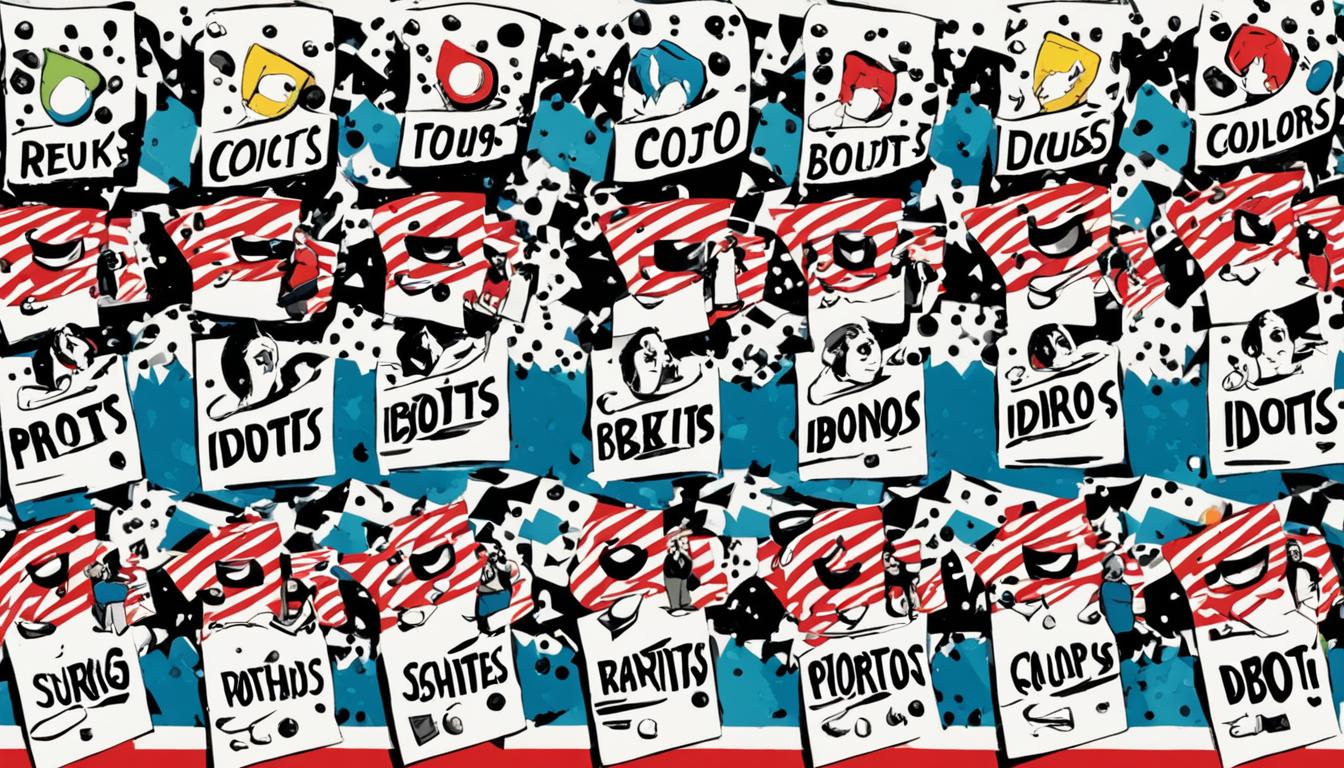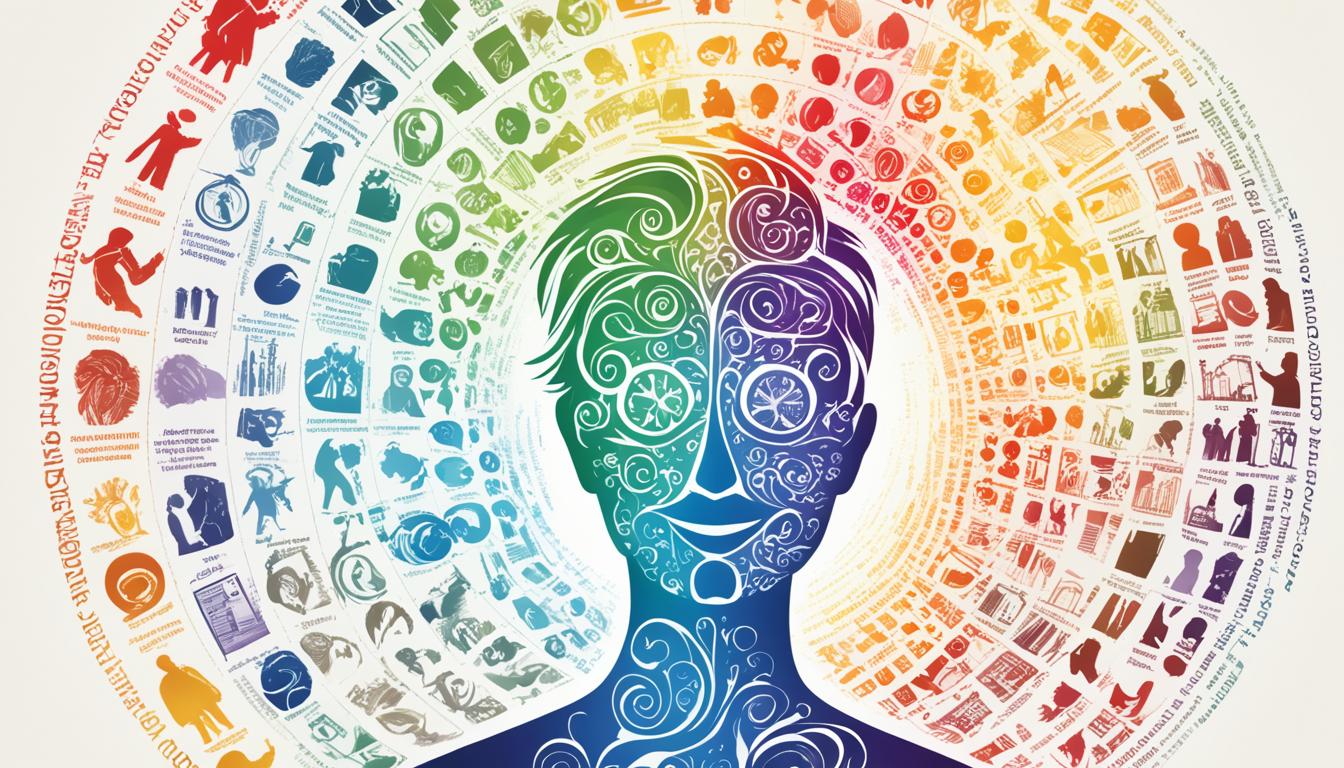Did you know that our personality characteristics and ways we communicate can be classified into four distinct colors? This interesting concept is explored in the book “Surrounded by Idiots” by Thomas Erikson. By familiarizing ourselves with these four color characteristics – Red, Yellow, Green, and Blue – we can gain valuable insights into our own behavior and better understand the actions of those around us. Let’s delve deeper into this fascinating subject and uncover the secrets behind the colorful world of personality types and communication styles.
Key Takeaways:
- 1. Thomas Erikson’s book “Surrounded by Idiots” categorizes personality types into four colors – Red, Yellow, Green, and Blue.
- 2. Each color represents different traits and communication styles that can help us understand others better.
- 3. Color psychology suggests that different colors can impact our perception and emotions.
- 4. Red personality types are often seen as dominant and controlling.
- 5. Yellow personality types may come across as talkative and scatterbrained.
An Introduction to the Colors
The four personality types in “Surrounded by Idiots” are represented by the colors Red, Yellow, Green, and Blue. These colors help describe the different traits and behaviors associated with each type. The book uses these colors as a shorthand for understanding and discussing personality types.
Understanding the characteristics of each color type can provide valuable insights into how individuals think, communicate, and interact with others. Let’s take a closer look at each color and its corresponding personality traits:
| Color | Personality Traits |
|---|---|
| Red | Assertive, decisive, results-oriented |
| Yellow | Outgoing, sociable, enthusiastic |
| Green | Harmonious, empathetic, patient |
| Blue | Analytical, detail-oriented, cautious |
Each color type possesses unique strengths and weaknesses, as well as preferred communication styles. By understanding these traits, we can navigate interpersonal relationships more effectively and adapt our approach to better connect with individuals of different personality types.
The Psychology of Color
The author of “Surrounded by Idiots” chose to use colors to represent the different personality types, but he doesn’t explain the specific reasons for choosing these colors. However, color psychology suggests that different colors can affect our perception and emotions. Understanding the psychology behind these colors can provide valuable insights into our interactions with others.
Let’s take a closer look at the associations and emotions commonly associated with the colors red, yellow, green, and blue:
| Color | Association | Emotions |
|---|---|---|
| Red | Dominance and aggression | Anger, passion, power |
| Yellow | Optimism and energy | Happiness, positivity, creativity |
| Green | Calming and nurturing | Harmony, growth, stability |
| Blue | Serenity and reliability | Trust, peace, loyalty |
These associations and emotions can provide valuable insights into how individuals with different personality types may perceive and interact with the world around them. For example, someone with a red personality type might be more likely to exhibit dominant and aggressive behaviors, while someone with a blue personality type might value stability and reliability in their interactions.
“Colors have a powerful effect on how we perceive and experience the world. By understanding the psychology of color, we can better understand others and adapt our communication and behaviors to foster stronger connections.”
Overall, color psychology offers a framework for understanding the potential impact of color on human behavior and emotions. While the specific reasons behind the author’s choice of colors in “Surrounded by Idiots” may remain a mystery, we can still draw upon the broader field of color psychology to gain insights into how different personality types may interact and perceive the world.

Negative Perceptions of Red Personality Types
Red personality types in “Surrounded by Idiots” are often perceived as overbearing and controlling. They like to be in charge and may not give others much autonomy. Red personalities are also seen as insensitive because they may not engage in long conversations unless they are truly interested in the topic. This behavior can be seen as cold-hearted and rude by others.
Red personality types, as categorized by Thomas Erikson in “Surrounded by Idiots,” exhibit dominant and assertive traits. They thrive in leadership roles and prefer to take control of situations. However, their strong desire for control can sometimes be seen as overbearing and controlling by others.
Red personalities have a direct and no-nonsense communication style. They value efficiency and practicality, which often means they can skip small talk and get straight to the point. While this can be appreciated in certain settings, such as business meetings, it may come across as insensitive or dismissive in more casual or social situations. Others may perceive red personality types as lacking empathy, as they tend to prioritize their own interests and goals over engaging in lengthy conversations that don’t align with their personal interests.
“Red personality types may be perceived as cold-hearted and rude due to their inclination to prioritize efficiency and results over social niceties.”
It is important to note that these negative perceptions of red personality types are based on generalizations, and not all individuals categorized as red will exhibit the same behaviors or traits. Additionally, the negative perceptions may stem from misunderstandings or misinterpretations of the red communication style.
Understanding the red personality type and being aware of these negative perceptions can help facilitate better communication and relationships with individuals who exhibit these traits. By recognizing their need for control and their direct communication style, we can navigate interactions more effectively and avoid misinterpreting their intentions.
Ultimately, the negative perceptions associated with red personality types should not overshadow the valuable strengths and qualities they bring to various situations, such as their ability to make decisions quickly and their drive to achieve results. By embracing the diversity of personality types, we can foster more understanding and inclusive environments.
Key Points:
- Red personality types are often seen as overbearing and controlling.
- They may prioritize efficiency over engaging in lengthy conversations.
- Others may perceive them as lacking empathy.
- Understanding the red personality type can improve communication and relationships.
Negative Perceptions of Yellow Personality Types
When it comes to yellow personality types in “Surrounded by Idiots,” there are often negative perceptions that arise. These perceptions stem from specific traits and behaviors associated with yellow personalities. Let’s delve into some of the common negative perceptions:
Dominance in Conversations
Yellow personality types tend to be overly talkative and dominant in conversations. They have a strong desire to express their thoughts and ideas, sometimes overshadowing others and not allowing them to participate fully. This can give the impression that yellow personalities are self-centered and dismissive of others’ perspectives.
Scatterbrained and Unfinished Projects
Another negative perception of yellow personality types is their tendency to start many projects but fail to see them through to completion. They may have a constant need for excitement and novelty, leading to scattered focus and difficulty maintaining interest in one task for an extended period. Others may see this behavior as unreliable and lacking commitment.
Unconventional Organizational Systems
Yellow personalities often have unique organizational systems that they develop to suit their own needs and preferences. This can be confusing or frustrating for others who prefer more standardized and structured approaches. Yellow personality types might seem disorganized or chaotic, causing others to question their ability to prioritize and manage their responsibilities effectively.
“Yellow personalities have a colorful way of approaching life, which can be both engaging and overwhelming. Their enthusiasm and dominant presence in conversations can sometimes overshadow the voices of others.”
Yellow Personality Traits and Their Impact
It’s important to understand that negative perceptions of yellow personality types are not inherently true or accurate. While these traits can create challenges in certain situations, they also bring unique strengths and perspectives to the table. Yellow personalities are often creative, inspiring, and have a knack for thinking outside the box.
Understanding the negative perceptions associated with yellow personality types allows us to approach interactions with empathy and open-mindedness. By appreciating the individuality of each personality type, we can foster better communication and collaboration.
Next, let’s explore the negative perceptions surrounding green personality types and gain a deeper understanding of their traits and characteristics.

Negative Perceptions of Green Personality Types
Green personality types, as classified in “Surrounded by Idiots,” often face negative perceptions due to their unique traits and behaviors. These perceptions are based on misconceptions and misunderstandings. Let’s delve into the common negative perceptions of green personalities and debunk them:
Perception 1: Laziness and Indecisiveness
One common negative perception of green personality types is that they are lazy and indecisive. This stems from their preference for taking their time when making decisions. Green personalities value careful consideration and thorough evaluation before committing to a course of action. This may give the impression that they are hesitant or lack ambition. However, their deliberation is a result of their dedication to making informed choices.
Perception 2: Conflict Avoidance and Two-Faced Behavior
Another misperception about green personality types is their perceived conflict avoidance and tendency toward being two-faced. Green personalities tend to prefer peaceful and harmonious environments. They may avoid confrontations and disagreements, which can lead others to perceive them as non-confrontational or even manipulative. In reality, green personalities value harmony and seek to maintain positive relationships.
“Green personalities have a natural inclination towards creating harmony and avoiding conflicts. It’s important to understand that their avoidance of confrontation doesn’t imply malice or deception. Instead, it reflects their desire to foster an amicable and supportive environment.”
Perception 3: Gossiping and Lack of Confrontation
Some perceive green personality types as prone to gossiping and lacking the ability to address issues directly. Green personalities may express their concerns or frustrations about others, but they often choose to vent behind closed doors rather than confront the person involved. This can lead others to view them as two-faced and untrustworthy. However, it’s important to note that green personalities usually engage in such behavior as a means of emotional release rather than intending harm to others. They may find it challenging to confront others due to their aversion to conflict.
It’s crucial to understand that negative perceptions of green personality types are based on misunderstandings rather than their true character. Appreciating the unique strengths and qualities of green personalities can help foster understanding and create a more inclusive and harmonious environment.

| Negative Perceptions of Green Personality Types | Debunking Misconceptions |
|---|---|
| Laziness and Indecisiveness | Green personalities value careful consideration and informed decision-making. |
| Conflict Avoidance and Two-Faced Behavior | Green personalities prioritize maintaining positive relationships and fostering harmony. |
| Gossiping and Lack of Confrontation | Green personalities may express concerns privately, seeking emotional release rather than intending harm. |
Negative Perceptions of Blue Personality Types
When it comes to blue personality types in “Surrounded by Idiots,” there are often negative perceptions associated with them. Blues are commonly viewed as cold-hearted and emotionless, primarily because they prioritize personal space and tend to avoid small talk. They may come across as distant or detached, which can be misunderstood as a lack of empathy or warmth.
“Blues tend to value deep, meaningful conversations rather than engaging in superficial chit-chat. They prefer to focus on substantial topics and dig into the details,” explains Thomas Erikson in his book.
Another reason behind the negative perceptions of blue personality types is their tendency to identify problems rather than offering immediate solutions. Blues have a discerning eye for potential flaws and inconsistencies, which can make them appear critical or pessimistic. However, their intention is often to improve situations by highlighting areas that need attention.
Blues are known for their meticulous nature and insistence on thorough preparation. This trait can sometimes be interpreted as perfectionism, making it difficult for them to start new tasks without feeling fully equipped. It’s important to understand that this meticulousness stems from their desire to do things correctly and avoid mistakes.
The Misconception of Coldness
One common misconception is that blues are unemotional and devoid of warmth. In reality, they experience emotions deeply but may express them differently from other personality types. Blues tend to keep their emotions private, reserving them for intimate relationships or moments that they consider significant.
Their reserved nature can be misunderstood as aloofness or indifference, leading others to perceive them as being cold-hearted. However, once you break through their outer shell and establish a deeper connection, you will find a compassionate and caring individual underneath.
The Value of Blue Personality Types
Despite the negative perceptions surrounding blue personality types, they bring unique strengths to the table. Their ability to analyze complex situations and provide well-thought-out insights can be invaluable in decision-making processes. Blues excel at recognizing potential risks and identifying areas for improvement.
Furthermore, their preference for meaningful conversations allows them to delve into important subjects and extract valuable insights. This depth of conversation can lead to rich and fulfilling interactions, fostering genuine connections and understanding.
Breaking Stereotypes and Embracing Differences
It’s essential to challenge and break through the stereotypes associated with blue personality types. Instead of perceiving them as cold or negative, we should appreciate their unique perspectives and the depth they bring to conversations and problem-solving.
By embracing the differences in personality types, including blues, we can foster more inclusive and effective communication. Understanding that each personality type has its strengths and weaknesses enables us to work together more harmoniously and create stronger, more well-rounded teams.
| Negative Perceptions of Blue Personality Types | Realities of Blue Personality Types |
|---|---|
| Cold-hearted and emotionless | Reserved and private about emotions |
| Identify problems, but don’t offer solutions | Meticulous and detail-oriented problem solvers |
| Perfectionists, difficulty starting new tasks | Prefer thorough preparation to avoid mistakes |
Understanding and appreciating the blue personality types can lead to more effective collaboration and stronger relationships.

The Importance of Self-Awareness
Understanding ourselves is key to navigating the complexities of human interaction. It allows us to develop better relationships, enhance communication, and foster a deeper connection with others. In the book “Surrounded by Idiots,” Thomas Erikson emphasizes the significance of self-awareness in comprehending our own personality traits and how they impact the way we relate to others.
By being self-aware, we gain insights into our strengths and weaknesses. We become conscious of our preferred communication styles and learn to adapt them when engaging with different personality types. This awareness enables us to connect on a deeper level with others, leading to more meaningful and fulfilling relationships.
“To understand others, we must first understand ourselves.”
– Thomas Erikson
The Path to Improved Relationships
Self-awareness forms the foundation for improving relationships. When we are aware of our own personality traits, we become better equipped to understand and appreciate the differences in others. By recognizing that everyone has their unique way of thinking and communicating, we can approach interactions with empathy and patience.
Self-awareness allows us to identify areas for personal growth and development. It enables us to recognize our biases, emotional triggers, and blind spots, giving us the opportunity to work on them. By addressing these aspects of ourselves, we cultivate a greater understanding and acceptance of others, fostering harmonious connections and resolving conflicts more effectively.
The Power of Adaptation
Self-awareness empowers us to adapt our communication styles and behaviors to meet the needs of others. When we understand our own tendencies, we can modify our approach accordingly, ensuring that our messages are received and understood effectively.
When interacting with different personality types, self-awareness helps us tailor our communication techniques to match their preferences. For example, if we are engaging with a yellow personality type who appreciates lively discussions, we can adapt our communication style to be more open and enthusiastic. Similarly, when dealing with a blue personality type who values concise and logical information, we can provide them with organized and structured input.
The Journey to Self-Discovery
Self-awareness is an ongoing journey of self-discovery. It requires introspection, reflection, and a willingness to examine our thoughts, emotions, and behaviors. There are various techniques and tools available to support this journey, including self-reflection exercises, personality assessments, and seeking feedback from trusted individuals.
By embarking on this journey, we gain a deeper understanding of our own needs, desires, and motivations. This self-knowledge paves the way for personal growth, improved relationships, and a greater sense of fulfillment in our interactions with others.
| Key Benefits of Self-Awareness | How It Impacts Relationships |
|---|---|
| 1. Increased empathy | 1. Better understanding of others’ perspectives |
| 2. Improved communication | 2. Adaptation to different communication styles |
| 3. Conflict resolution | 3. Effective resolution of conflicts |
| 4. Personal growth and development | 4. Recognition and improvement of personal biases |
Embracing self-awareness allows us to embark on a transformative journey of personal and interpersonal growth. By understanding ourselves, we open doors to better understanding others, improving our relationships, and nurturing a harmonious social environment.

The Power of Understanding Different Personalities
Understanding different personality types, as described in “Surrounded by Idiots,” can greatly enhance our interpersonal skills and improve our relationships. By recognizing the traits and behaviors of others, we can tailor our communication to their preferences and foster better understanding and connection. This knowledge can also help us navigate conflicts and build stronger team dynamics.
We all have unique personality types that shape the way we think, feel, and interact with the world around us. By understanding these differences, we can bridge the gap between different communication styles and create meaningful connections.
Enhancing Interpersonal Skills
When we understand the various personality types, we are better equipped to adapt our communication strategies. For example, some individuals may thrive on direct and assertive communication, while others appreciate a more empathetic and collaborative approach. By recognizing these preferences, we can adjust our style to create a more effective and productive exchange.
Furthermore, understanding different personality types allows us to recognize and appreciate the strengths and weaknesses that each type brings to the table. This knowledge helps foster teamwork, as we can actively seek out diverse perspectives and leverage individual talents for improved problem-solving and decision-making processes.
Navigating Conflicts
Conflicts are inevitable in any relationship or team dynamic. However, when we understand different personality types, we can navigate these conflicts with greater empathy and understanding. By recognizing how each person’s traits and communication styles contribute to the conflict, we can approach resolution in a more collaborative and constructive manner.
Moreover, understanding the motivations and perspectives of different personality types allows us to de-escalate conflicts and find common ground. We can use effective communication techniques, such as active listening and asking clarifying questions, to foster open dialogue and reach mutually beneficial solutions.
Building Stronger Team Dynamics
When individuals with diverse personality types come together, there is an opportunity to create a dynamic and high-performing team. By understanding and harnessing the strengths of each personality type, we can build cohesive teams that capitalize on the unique talents and perspectives of its members.
Furthermore, recognizing the different communication styles and preferences within a team allows us to foster an inclusive and supportive environment. By adapting our communication strategies to accommodate these differences, we can ensure that everyone feels heard, valued, and motivated to contribute their best.
Overall, understanding different personality types not only enhances our interpersonal skills but also paves the way for stronger relationships and more effective communication. By embracing diversity and adapting our approach, we can build meaningful connections, resolve conflicts, and create harmonious team dynamics.
The Benefits of Color-Based Personality Profiling
Color-based personality profiling, such as the one presented in “Surrounded by Idiots,” offers a unique and insightful approach to understanding human behavior. By categorizing personality traits into colors, individuals can gain valuable self-awareness and a deeper understanding of others around them.
This type of personality assessment allows us to identify and explore our strengths, weaknesses, and communication styles. It provides a framework for personal development and growth, helping us navigate relationships and enhance our overall emotional intelligence.
With color-based personality profiling, we can:
- Recognize our strengths and leverage them for personal and professional success.
- Identify areas for improvement and work on developing new skills.
- Understand our communication style and adapt it to connect better with others.
- Build stronger and more fulfilling relationships by appreciating and respecting different personality types.
- Enhance our self-awareness and emotional intelligence, leading to better decision-making and problem-solving.
Applying Color-Based Personality Profiling in Personal Development
Color-based personality profiling can be instrumental in personal development journeys. By understanding our own color traits, we can tailor our growth strategies and unleash our full potential.
“The beauty of color-based personality profiling lies in its ability to reveal aspects of ourselves that we may not have been fully aware of. It gives us the power to make intentional choices in our personal and professional lives, contributing to our overall well-being and success.”
Through personal development initiatives, we can capitalize on our natural strengths and work on areas that may challenge us. This self-improvement journey empowers us to become more effective communicators, resilient problem-solvers, and successful leaders.
Improving Relationships with Color-Based Personality Profiling
One of the significant advantages of color-based personality profiling is its impact on our relationships. By understanding the color traits of those around us, we can foster empathy, adapt our communication styles, and build stronger connections.
“True connection and understanding come from appreciating and embracing the unique qualities of individuals, regardless of their color traits. Color-based personality profiling serves as a bridge to cultivate meaningful relationships based on mutual respect and acceptance.”
When we recognize that individuals may have different preferences and communication styles, we can adjust our approach to ensure effective communication and collaboration. By embracing diversity and appreciating the strengths of others, we create an inclusive and harmonious environment for personal and professional growth.
Enhancing Overall Self-Awareness and Emotional Intelligence
Color-based personality profiling is not merely a tool for understanding others but also a means of exploring our own personalities. By gaining insights into our color traits, we enhance our self-awareness and develop a deeper understanding of our emotions, behaviors, and decision-making processes.
With this heightened self-awareness, we become better equipped to navigate life’s challenges, manage our emotions effectively, and make informed choices that align with our values and goals.
Ultimately, color-based personality profiling offers a holistic framework for personal growth, improved relationships, and enhanced self-awareness. By embracing the insights it provides, we can embark on a transformative journey towards understanding ourselves and others in a more profound and meaningful way.

Conclusion
“Surrounded by Idiots” provides an enlightening exploration of the four color traits that shape our interactions with others. By understanding and embracing these traits, we can unlock the power to enhance our communication skills, build stronger relationships, and gain a deeper understanding of ourselves and those around us.
The four colors – Red, Yellow, Green, and Blue – represent distinct personality types, each with its own unique set of traits and communication styles. By familiarizing ourselves with these colors, we can navigate the complexities of human behavior and adapt our approach to better connect with others.
Through this valuable guide, we discover the importance of self-awareness and how it empowers us to improve our relationships. By recognizing our strengths and weaknesses, we can tailor our communication styles and behaviors, ensuring a more harmonious interaction with different personality types.
In summary, “Surrounded by Idiots” equips us with the tools to understand and appreciate the diverse ways in which people perceive the world. By embracing the four colors and the traits they represent, we become better equipped to navigate the intricacies of social dynamics, fostering empathy, collaboration, and meaningful connections.
FAQ
What are the four colors in “Surrounded by Idiots”?
The four colors in “Surrounded by Idiots” are Red, Yellow, Green, and Blue.
How do the colors represent different traits and behaviors?
Each color represents different personality traits and communication styles. Red is associated with dominance and aggression, Yellow with optimism and energy, Green with calmness and nurturing, and Blue with serenity and reliability.
Why did the author choose to use colors to represent the personality types?
The author doesn’t explain the specific reasons, but color psychology suggests that different colors can affect our perception and emotions, making them a useful shorthand for understanding and discussing personality types.
How are Red personality types perceived by others?
Red personality types are often seen as overbearing and controlling, with a tendency to be insensitive and disinterested in long conversations.
How are Yellow personality types perceived by others?
Yellow personality types are often seen as overly talkative, dominant in conversations, and scatterbrained due to their tendency to start many projects without finishing them.
How are Green personality types perceived by others?
Green personality types are often seen as lazy, two-faced, and conflict-avoidant due to their preference for taking time in making decisions and staying home.
How are Blue personality types perceived by others?
Blue personality types are often seen as cold-hearted, emotionless, and negative because they value personal space, avoid small talk, and may struggle to start new tasks.
Why is self-awareness important in understanding personality types?
Self-awareness allows us to recognize and understand our own traits and behaviors, which helps us improve our relationships and adapt our communication styles to connect better with others.
How can understanding different personality types improve relationships?
Understanding different personality types allows us to tailor our communication to others’ preferences, fostering better understanding, connection, and the ability to navigate conflicts and build stronger team dynamics.
What are the benefits of color-based personality profiling?
Color-based personality profiling provides insights into our strengths, weaknesses, and communication styles, promoting personal development, improving relationships, and enhancing self-awareness and emotional intelligence.
How does “Surrounded by Idiots” help us understand human behavior?
“Surrounded by Idiots” explores the four color traits and their impact on our interactions, enhancing our communication skills, relationships, and overall understanding of ourselves and others.
Emmeline is the backbone of our content creation team, bringing complex psychological concepts to life with clarity and empathy. As our Expert Writer, she crafts engaging, insightful articles that guide readers through the intricacies of personality assessments and what they reveal about the human condition. Her passion for psychology and personal development shines through in every piece she writes.










